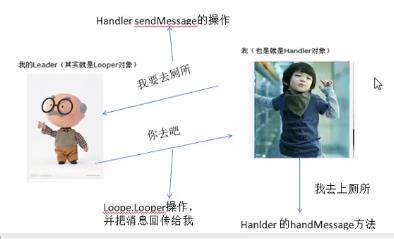带你深入理解Android Handler机制
Posted KennyBiggerJava
tags:
篇首语:本文由小常识网(cha138.com)小编为大家整理,主要介绍了带你深入理解Android Handler机制相关的知识,希望对你有一定的参考价值。
带你深入理解android Handler机制
欢迎转载请注明来源
说到消息机制,我们一定会想到Handler,由于Android系统规定主线程不能阻塞超过5s,否则会出现”Application Not Responding”。也就是说,你不能在主线程中进行耗时操作(网络请求,数据库操作等),只能在子线程中进行。下面先来看一下在子线程中访问UI会出现什么情况。
public void click(View v){
new Thread(new Runnable() {
@Override
public void run() {
mTextView.setText("2");
}
}) .start();
}
结果不出意外的报错:
android.view.ViewRootImpl$CalledFromWrongThreadException: Only the original thread that created a view hierarchy can touch its views.
在ViewRootImpl的checkThread()检查是否是主线程,如果不是抛异常。

那么这个时候怎么解决才能在更新UI呢?其实就是用Handler机制啦!
Handler
先来看一下如何改进代码,然后详细分析Handler机制。
public void click(View v){
new Thread(new Runnable() {
@Override
public void run() {
//拿到Message对象
Message msg = mHandler.obtainMessage();
msg.arg1 = 2;
mHandler.sendMessage(msg);
}
}) .start();
}
然后在handleMessage中更新UI
private Handler mHandler = new Handler(){
@Override
public void handleMessage(Message msg) {
super.handleMessage(msg);
mTextView.setText(msg.arg1+"");
}
};
这样就成功了。
仅仅知道怎么用那肯定是不够的,我们还需要知道其背后到底干了什么。
我们就从 mHandler.sendMessage(msg)开始说起吧。当我们调用sendMessage时候,其实最终调用的是sendMessageAtTime(msg,long)。此方法源码如下:
public boolean sendMessageAtTime(Message msg, long uptimeMillis) {
MessageQueue queue = mQueue;
if (queue == null) {
RuntimeException e = new RuntimeException(
this + " sendMessageAtTime() called with no mQueue");
Log.w("Looper", e.getMessage(), e);
return false;
}
return enqueueMessage(queue, msg, uptimeMillis);
}
它会调用enqueueMessage()将Message送到MessageQueue中去。那么MessageQueue是什么呢?顾名思义是消息队列,其实在我们创建Handler的时候,它需要与Looper作关联,Looper类有一个成员变量
MessageQueue mQueue,它就是消息队列。用来接收Handler发送Message。MessageQueue内部并不是用数组存储的,而是用链表的数据结构,方便添加和删除。
下面来看一下Looper.looper()源码,这个方法就是将Message交给Handler.handleMessage去完成的。
public static void loop() {
final Looper me = myLooper();
if (me == null) {
throw new RuntimeException("No Looper; Looper.prepare() wasn't called on this thread.");
}
final MessageQueue queue = me.mQueue;
// Make sure the identity of this thread is that of the local process,
// and keep track of what that identity token actually is.
Binder.clearCallingIdentity();
final long ident = Binder.clearCallingIdentity();
for (;;) {
Message msg = queue.next(); // might block
if (msg == null) {
// No message indicates that the message queue is quitting.
return;
}
// This must be in a local variable, in case a UI event sets the logger
Printer logging = me.mLogging;
if (logging != null) {
logging.println(">>>>> Dispatching to " + msg.target + " " +
msg.callback + ": " + msg.what);
}
msg.target.dispatchMessage(msg);
if (logging != null) {
logging.println("<<<<< Finished to " + msg.target + " " + msg.callback);
}
// Make sure that during the course of dispatching the
// identity of the thread wasn't corrupted.
final long newIdent = Binder.clearCallingIdentity();
if (ident != newIdent) {
Log.wtf(TAG, "Thread identity changed from 0x"
+ Long.toHexString(ident) + " to 0x"
+ Long.toHexString(newIdent) + " while dispatching to "
+ msg.target.getClass().getName() + " "
+ msg.callback + " what=" + msg.what);
}
msg.recycleUnchecked();
}
}
第3,4行:判断Looper对象是否为空,如果是空,抛出”No Looper; Looper.prepare() wasn’t called on this thread.”异常。换句话说,如果我们在子线程中创建Handler,并调用sendMessage()时候,由于没有Looper对象,就会抛此异常信息。我们可以通过Looper.prepare()将当前线程转为Looper线程。该源码会在下面分析。
主要看 for (;;)那段代码,它是个死循环,不断地执行next()方法,如果有新消息,就交给 msg.target.dispatchMessage(msg);这里msg.target其实就是Handler对象。那么下面我们看一下Handler.dispatchMessage(msg)到底干了什么。
public void dispatchMessage(Message msg) {
if (msg.callback != null) {
handleCallback(msg);
} else {
if (mCallback != null) {
if (mCallback.handleMessage(msg)) {
return;
}
}
handleMessage(msg);
}
}
其实看到这里就明白了,它调用的就是handleMessage(),所以我们就可以轻松的更新UI界面了!
那么mCallback.handleMessage(msg)是什么呢?
接下来我们看一下这个代码:
private Handler mHandler = new Handler(new Handler.Callback() {
@Override
public boolean handleMessage(Message msg) {
Toast.makeText(getApplicationContext(),"1",Toast.LENGTH_SHORT).show();
return false;
}
}){
@Override
public void handleMessage(Message msg) {
Toast.makeText(getApplicationContext(),"2",Toast.LENGTH_SHORT).show();
}
};
注意:在第5行我return false,结果吐司展现1,展现完之后再展示2.
当return true时,结果吐司只展现1。这样我们就可以知道,这其实是用来拦截处理消息的。
刚刚提到Looper.prepare()可以将当前线程转为Looper线程。那看一下Looper.prepare()源码
private static void prepare(boolean quitAllowed) {
if (sThreadLocal.get() != null) {
throw new RuntimeException("Only one Looper may be created per thread");
}
sThreadLocal.set(new Looper(quitAllowed));
}
通过抛出的那个异常我们可以发现一个Handler只能有一个Looper.而一个Looper内部维护者MessageQueue,当有消息时Looper从MessageQueue中取出消息交给Handler处理。这样它们之间就建立起关系了。
看一下源码中的这行代码 sThreadLocal.set(new Looper(quitAllowed)); 关于ThreadLocal可以看一下我的这篇文章
要想到Looper不断的从MessageQueue中取消息,就必须调用Looper.loop()来不断取消息.
在子线程中发送消息的完整代码如下:
public void click(View v){
final Handler handler = new Handler();
new Thread(new Runnable() {
@Override
public void run() {
Looper.prepare();
handler.sendMessage();
Looper.loop();
}
}) .start();
}
注意 Looper.prepare(); handler.sendMessage();这二个方法顺序不能变,我们可以看一下Handler构造方法
public Handler(Callback callback, boolean async) {
if (FIND_POTENTIAL_LEAKS) {
final Class<? extends Handler> klass = getClass();
if ((klass.isAnonymousClass() || klass.isMemberClass() || klass.isLocalClass()) &&
(klass.getModifiers() & Modifier.STATIC) == 0) {
Log.w(TAG, "The following Handler class should be static or leaks might occur: " +
klass.getCanonicalName());
}
}
mLooper = Looper.myLooper();
if (mLooper == null) {
throw new RuntimeException(
"Can't create handler inside thread that has not called Looper.prepare()");
}
mQueue = mLooper.mQueue;
mCallback = callback;
mAsynchronous = async;
}
注意这段代码 mLooper = Looper.myLooper();如果为空,抛异常,该异常意思是必须调用Looper.prepare().这就是说为什么顺序不能改变!
那么读者可能会问,我们在主线程创建Handler对象,并没有调用Looper.prepare()也出什么问题啊,的确是这样的,因为ActivityThread 的main()函数里面 Looper.prepareMainLooper();已经自动帮我们创建好了Looper对象了。看一下源码:
public static void prepareMainLooper() {
prepare(false);
synchronized (Looper.class) {
if (sMainLooper != null) {
throw new IllegalStateException("The main Looper has already been prepared.");
}
sMainLooper = myLooper();
}
}
注意sMainLooper = myLooper();看一下myLooper()方法:
public static @Nullable Looper myLooper() {
return sThreadLocal.get();
}
讲了这么多,估计对于小白来说有点晕了。哈哈。那么接下来我盗用一张hyman老师的一张图分析Handler,MessageQueue,Looper之间的关系吧。。。
 0160904160222603)
0160904160222603)
一天,老板正在和员工开会,员工想上厕所,出于礼貌,对老板说我要去上厕所(sendMessage 到 MessageQueue中) 老板思考了一会儿,回复到”你去吧”(Looper.loop()) , 最后员工去WC了(handleMessage) ,从询问到最后WC都是员工做的事,这就是它们之间的关系了。。。哈哈哈。
其实Handler发送消息有多种方式
- msg.sendToTarget();
- mHandler.sendMessageAtFrontOfQueue();
- mHandler.sendEmptyMessage()
- mHandler.sendEmptyMessageDelayed()
- mHandler.post()
- mHandler.postDelayed()
虽然有多种方法,但本质都是通过Handler.handleMessage()实现的。
还有几个这里就不一一列举了,有兴趣的读者可以去Android官网吧。。。
声明
感谢《Android开发艺术探索》,感谢慕课网视频,感谢郭神。
我来附一下链接吧,感兴趣的话去看一下吧。。。
视频:
郭神博客:
最后:这是笔者第一次写分析源码的文章,(估计也是最后一次了吧。。。哈哈哈。。),写的不好,比较杂乱,还请读者多多包涵。写着写着就过了24点了,即将迎来大三,希望用这篇文章来为准大三生活开个好头吧!祝大家生活愉快!
以上是关于带你深入理解Android Handler机制的主要内容,如果未能解决你的问题,请参考以下文章